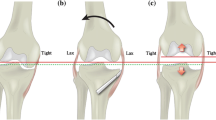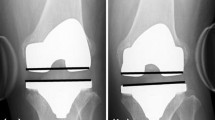Abstract
Instruction
Total knee arthroplasty (TKA) performed with the gap technique can achieve rectangular gaps during flexion and extension by proper bone resection and subsequent soft tissue release. Acquisition of appropriate soft tissue balance is important for successful TKA. It is unknown, however, whether the intraoperative well-balanced ligamentous laxity changes postoperatively over time. We hypothesized that even if good soft tissue balance was achieved intraoperatively the lateral ligamentous laxity would increase with time postoperatively. This phenomenon depends on preoperative background factors.
Methods
We used the angle between the component surfaces of the tibia and femur to define ligamentous laxity. Changes in ligamentous laxity after posterior stabilized minimally invasive surgery (MIS)-TKA were analyzed retrospectively in 150 knees based on radiographic measurements. At 12 months after the operation, the cases were divided into two groups in which the lateral ligamentous laxity in flexion was either ≤3° (balanced group) or >3° (unbalanced group). Factors with a potential to encourage postoperative ligamentous laxity were analyzed.
Results
Our data show that the postoperative ligamentous laxity in extension did not change, whereas the lateral ligamentous laxity in flexion increased with time. This change was significantly related to the preoperative lateral ligamentous laxity, body weight, body mass index, and age.
Conclusion
The results of this study should be taken into account by surgeons performing MIS-TKA with the gap technique.



Similar content being viewed by others
References
Sasanuma H, Sekiya H, Takatoku K, Takada H, Sugimoto N (2010) Evaluation of soft-tissue balance during total knee arthroplasty. J Orthop Surg 18:26–30
Romero J, Stähelin T, Binkert C, Pfirrmann C, Hodler J, Kessler O (2007) The clinical consequences of flexion gap asymmetry in total knee arthroplasty. J Arthroplasty 22:235–240
Fehring TK, Odum S, Griffin WL, Mason JB, Nadaud M (2001) Early failures in total knee arthroplasty. Clin Orthop Relat Res 392:315–318
Yagishita K, Muneta T, Ikeda H (2003) Step-by-step measurements of soft tissue balancing during total knee arthroplasty for patients with varus knees. J Arthroplasty 18:313–320
Yoshino N, Watanabe N, Watanabe Y, Fukuda Y, Takai S (2009) Measurement of joint gap load in patella everted and reset position during total knee arthroplasty. Knee Surg Sports Traumatol Arthrosc 17:484–490
Bellemans J, Hooghe PD, Vandenneucker H, Damme GV, Victor J (2006) Soft tissue balance in total knee arthroplasty. Clin Orthop Relat Res 452:49–52
Yagishita K, Muneta T, Yamamoto H, Shinomiya K (2001) The relationship between postoperative ligament balance and preoperative varus deformity in total knee arthroplasty. Bull Hosp Jt Dis 60:23–28
Sekiya H, Takatoku K, Takada H, Sasanuma H, Sugimoto N (2009) Postoperative lateral ligamentous laxity diminishes with time after TKA in the varus knee. Clin Orthop Relat Res 467:1582–1586
Okazaki K, Miura H, Matsuda S, Takeuchi N, Mawatari T, Hashizume M, Iwamoto Y (2006) Asymmetry of mediolateral laxity of the normal knee. J Orthop Sci 11:264–266
Matsuda S, Miura H, Nagamine R, Urabe K, Harimaya K, Matsunobu T, Iwamoto Y (1999) Changes in knee alignment after total arthroplasty. J Arthroplasty 14:566–570
Graichen H, Strauch M, Katzhammer T, Zichner L, von Eisenhart-Rothe R (2007) Ligament instability in total knee arthroplasty—causal analysis. Orthopade 36(650):652–656
Dennis DA, Komistek RD, Kim RH, Sharma A (2010) Gap balancing versus measured resection technique for total knee arthroplasty. Clin Orthop Relat Res 468:102–107
Tokuhara Y, Kadoya Y, Kanekasu K, Kondo M, Kobayashi A, Takaoka K (2006) Evaluation of the flexion gap by axial radiography of the distal femur. J Bone Joint Surg Br 88:1327–1330
Griffin FM, Insall JN, Scuderi GR (2000) Accuracy of soft tissue balancing in total knee arthroplasty. J Arthroplasty 15:970–973
Asano H, Hoshino A, Wilton TJ (2004) Soft-tissue tension total knee arthroplasty. J Arthroplasty 19:558–561
Niki Y, Takeda Y, Kanagawa H, Iwamoto W, Matsumoto H, Enomoto H, Toyama Y, Suda Y (2012) Effects of four different surgical approaches on intra-operative joint gap in posterior-stabilized total knee arthroplasty. Knee Surg Sports Traumatol Arthrosc 20:2026–2031
Kanekasu K, Kondo M, Kadoya Y (2004) Axial radiography of the distal femur to assess rotational alignment in total knee arthroplasty. Clin Orthop Relat Res 434:193–197
Tokuhara Y, Kadoya Y, Nakagawa S, Kobayashi A, Takaoka K (2004) The flexion gap in normal knees: an MRI study. J Bone Joint Surg Br 86:1133–1136
Freeman MA (1997) Soft tissues: a question of balance. Orthopedics 20:827–831
Insall JN, Binazzi R, Soudry M, Mestriner LA (1985) Total knee arthroplasty. Clin Orthop Relat Res 192:13–22
Onoda Y, Hagiwara Y, Ando A, Watanabe T, Chimoto E, Suda H, Yabe Y, Saijo Y, Itoi E (2013) Joint haemorrhage partly accelerated immobilization-induced synovial adhesions and capsular shortening in rats. Knee Surg Sports Traumatol Arthrosc Sep 8. [Epub ahead of print]
Hananouchi T, Yamamoto K, Ando W, Fudo K, Ohzono K (2012) The intraoperative gap difference (flexion gap minus extension gap) is altered by insertion of the trial femoral component. Knee 19:601–605
Conflict of interest
The authors declare that they have no conflict of interest.
Author information
Authors and Affiliations
Corresponding author
Rights and permissions
About this article
Cite this article
Hayashi, S., Murakami, Y., Inoue, H. et al. Changes in ligamentous laxity after posterior stabilized total knee replacement and factors correlated with postoperative laxity. Eur Orthop Traumatol 5, 267–272 (2014). https://doi.org/10.1007/s12570-013-0239-6
Received:
Accepted:
Published:
Issue Date:
DOI: https://doi.org/10.1007/s12570-013-0239-6




